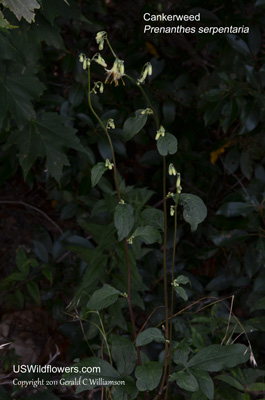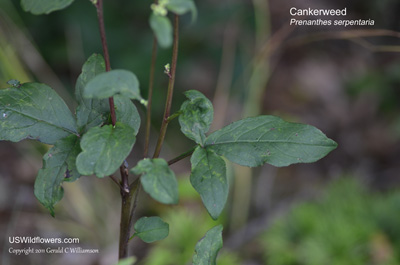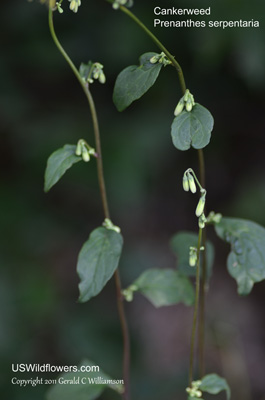Cankerweed, Lion's Foot, Snakeweed, Earthgall, Butterweed - Prenanthes serpentaria
|
Prenanthes serpentaria - Cankerweed, Lion's Foot, Snakeweed, Earthgall, Butterweed. Found on the eastern seaboard and Appalachian Mountain states as far south as Florida and as far west as Mississippi, Prenanthes serpentaria is Endangered in Massachusetts and a species of Special Concern in Rhode Island. The species epithet serpentaria and the genus common name Rattlesnakeroot come from the use of a tonic historically made from the roots or the milky juice of the stem as an antidote for the poison of snake bites.
There are similar Prenanthes species found in Haywood County, North Carolina, where these photos were taken. I discounted P. trifoliolata because that species has more angular leaves and fewer heads in each inflorescence. I discounted P. altissima because of the general appearance of the plant vis-a-vis photos at the USDA Plants Database, and the number of phyllaries in that species - normally five, not more than 6.
Found in:
AL, CT, DC, DE, FL, GA, KY, MA, MD, MS, NC, NH, NJ, NY, OH, PA, RI, SC, TN, VA, VT, WV
Leave comments on Prenanthes serpentaria at this link. | 
Distribution of Prenanthes serpentaria in the United States and Canada:

Blue=Native; Grey=Introduced
Map from USDA Plants Database:
USDA, NRCS. 2017. The PLANTS Database (http://plants.usda.gov, 08 May 2025). National Plant Data Team, Greensboro, NC 27401-4901 USA.
Search Our Database: Enter any portion of the Scientific, Common Name, or both.
Do a general Google search of the entire site:
#ad
 Follow USWildflowers on Twitter
| | Site: Blue Ridge Parkway, Haywood County, NC Date: 2011-August-01 | Photographer: Gerald C. Williamson
Nikon D7000
Tamron SP 90MM f/2.8 AF Macro | | Prenanthes have only ray florets, no disk florets. Counting ray florets and phyllaries are among the ways to differentiate between species. P. serpentaria has 8 up to 19 ray florets but usually 10 to 14, and 7 to 10, usually 8 phyllaries. P. trifoliolata 8 to 13 florets and 7 to 10 phyllaries. P. altissima normally has a count of 5 both florets and phyllaries, but may have as few as 4 or as many as 6. | | 
| | Site: Blue Ridge Parkway, Haywood County, NC Date: 2011-August-01 | Photographer: Gerald C Williamson
Nikon D7000
Tamron SP 90MM f/2.8 AF Macro | | The stem of Prenanthes species are usually upright (except for P. bootii.) The stems of most species are glabrous in the lower part and most species may be hairy in the upper part. All Prenanthes species have nodding flower heads - the genus name comes from the Greek words for "drooping" (prenes) and flower (anthos). Prenanthes serpentaria may be 18 inches to over 6 feet tall. | | Click on the photo for a larger image

| | Site: Blue Ridge Parkway, Haywood County, NC Date: 2011-August-01 | Photographer: Gerald C Williamson
Nikon D7000
Tamron SP 90MM f/2.8 AF Macro | | The lower (proximal) leaves of Cankerweed are deeply lobed, as are those of several Prenanthes species. The lobes of Prenanthes serpentaria are usually more rounded than those of P. trifoliolata and P. altissima, although those of P. altissima may also be rounded. The petioles of each are winged. | | Click on the photo for a larger image

| | Site: Blue Ridge Parkway, Haywood County, NC Date: 2011-August-01 | Photographer: Gerald C Williamson
Nikon D7000
Tamron SP 90MM f/2.8 AF Macro | | The upper (distal) leaves of all three Prenanthes species discussed here are reduced in size and are usually unlobed. | | Click on the photo for a larger image

|
References used for identification and information:
|
|
| |
| #ad
|
|






